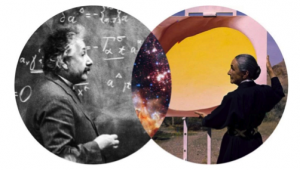By Kelsey Gray
If you were to play a word-association game and make lists of the words that go with science and the words that go with art, what would those lists look like? Would the lists have much overlap? Or would each list be distinct? What would you have included on each list?
I expect that if Albert Einstein had played this game, his lists would have looked pretty similar to one another. He said: “The most beautiful experience we can have is the mysterious, the fundamental emotion which stands at the cradle of true art and true science.” In other words, “mysterious” would have been on both his art and science lists.
According to Nobel laureate Eric Kandel, science and art share the same fundamental questions; they just approach these questions from different perspectives. For example, people are naturally curious about perception, memory, emotion, empathy, and creativity. These are many of the characteristics that make us human. Scientists study them by examining regions of the brain, neurons, and neurotransmitters. These characteristics can also be explored through writing, drawing, dancing, and playing music. In this sense, science and art are complementary ways to learn about the same aspects of human experience.

From brainpickings by Maria Popova
In addition to these indirect ways that science and art relate to the same topics, there are many examples of explicit cross-pollination of art and science. In the 1800s, neuroscientist Ramon y Cajal made numerous, beautiful drawings of neurons as part of his research. More recently, scientists such as Janet Iwasa, who learned animation techniques in Hollywood, create intriguing movies to show processes that happen inside of cells. Vividly illustrating activity at a microscopic scale, these animations help scientists develop hypotheses and come up with new ideas for experiments.
The creation of many types of artwork relies on science. Different chemicals and temperatures are used in pottery to generate various textures and colors that contribute to the complex patterns observed on different pieces. Drawings and writing can be used to share scientific stories such as the tales of trailblazing women in science, the life and theories of Albert Einstein, or taking a journey to visit trees of the world.
Science and art have been intertwined throughout history, and new connections are being made every day. Now, let’s revisit those lists. What does yours look like now? Here’s mine for both science and art: imagination, inspiration, expression, discovery, emotion, action, courage, transformative, trained knowledge, unknown, change, thinking, process, and to steal from Albert Einstein, mysterious.
Edited by Anna Chiarella and Yitong Li
